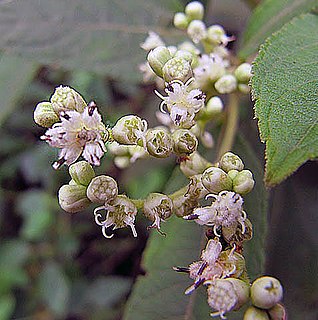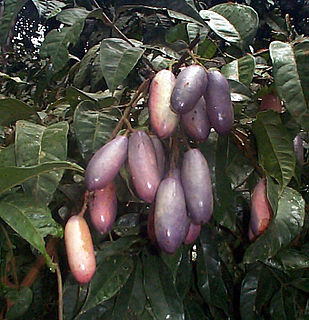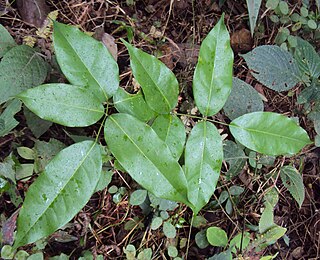
Gaultheria is a genus of about 135 species of shrubs in the family Ericaceae. The name commemorates Jean François Gaultier of Quebec, an honour bestowed by the Scandinavian Pehr Kalm in 1748 and taken up by Carl Linnaeus in his Species Plantarum. These plants are native to Asia, Australasia and North and South America. In the past, the Southern Hemisphere species were often treated as the separate genus Pernettya, but no consistent reliable morphological or genetic differences support recognition of two genera, and they are now united in the single genus Gaultheria.

Theobroma is a genus of flowering plants in the mallow family, Malvaceae, that is sometimes classified as a member of Sterculiaceae. It contains roughly 20 species of small understory trees native to the tropical forests of Central and South America. The generic name is derived from the Greek words θεός (theos), meaning "god," and βρῶμα (broma), meaning "food". It translates to "food of the gods."

Zanthoxylum is a genus of about 250 species of deciduous and evergreen trees, shrubs and climbers in the family Rutaceae that are native to warm temperate and subtropical areas worldwide. It is the type genus of the tribe Zanthoxyleae in the subfamily Rutoideae. Several of the species have yellow heartwood, to which their generic name alludes.

Tetrorchidium is a genus of flowering plants in the family Euphorbiaceae first described in 1841. It is native to tropical portions of Africa and the Western Hemisphere.

Vismia is a genus of flowering plants in the family Hypericaceae. Members of the genus are small trees and shrubs found in tropical and subtropical areas of Africa, Central America, and South America.

Guarea is a genus of evergreen trees in the family Meliaceae, native to tropical Africa and Central and South America. They are large trees 20–45 m tall, with a trunk over 1 m diameter, often buttressed at the base. The leaves are pinnate, with 4–6 pairs of leaflets, the terminal leaflet present. The flowers are produced in loose inflorescences, each flower small, with 4–5 yellowish petals. The fruit is a four or five-valved capsule, containing several seeds, each surrounded by a yellow-orange fleshy aril; the seeds are dispersed by hornbills and monkeys which eat the aril.

Weinmannia is a genus of trees and shrubs in the family Cunoniaceae. It is the largest genus of the family with about 150 species. It is also the most widespread genus, occurring in Central and South America including the Caribbean, Madagascar and surrounding islands, Malesia and the islands of the South Pacific. It is absent from mainland Africa and Australia, but some fossils have been attributed to Weinmannia in Australia. Leaves are simple or pinnate, with a margin usually toothed, and interpetiolar stipules. Flowers are bisexual, white, arranged in racemes. The fruit is a capsule opening vertically from the top to the base. Seeds hairy without wings.

Aequatorium is a genus of flowering plants in the aster family. It was described as a genus in 1978. It is a member of the tribe Senecioneae and native to South America.

Clibadium is a genus of flowering plants in the sunflower family.
Llerasia is a genus of South American flowering plants in the sunflower family.

Brunellia is a genus of trees. They are distributed in the mountainous regions of southern Mexico, Central America, West Indies, and South America. Brunellia is the only genus in the family Brunelliaceae. As of 2001 there were about 54 species.

Espeletia, commonly known as 'frailejones', is a genus of perennial subshrubs, in the sunflower family. The genus, which is native mainly to Colombia, Venezuela and Ecuador, was first formally described in 1808. The genus was named after the viceroy of New Granada, José Manuel de Ezpeleta.
Myriactis is a genus of flowering plants in the aster tribe within the sunflower family.

Dacryodes is a genus of about 60 species of trees in the family Burseraceae. The generic name is from the Greek dakruon meaning "tear(drop)", referring to how resin droplets form on the bark surface.

Connarus is a genus of plants in the family Connaraceae.

Rourea is a genus of plants in the family Connaraceae. They are found worldwide across the tropics and subtropics.
Talamancaster is a genus of flowering plants belonging to the family Asteraceae.
Coussapoa is a genus of flowering plants belonging to the family Urticaceae.
Endopleura is a genus of flowering plants belonging to the family Humiriaceae.
Hymenandra is a genus of flowering plants belonging to the family Primulaceae.













